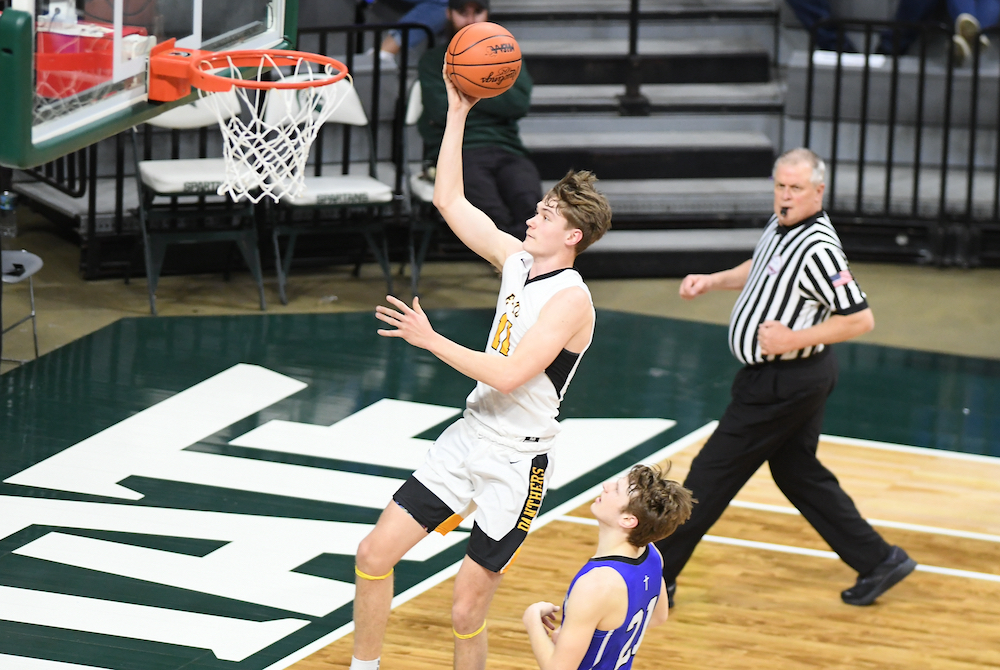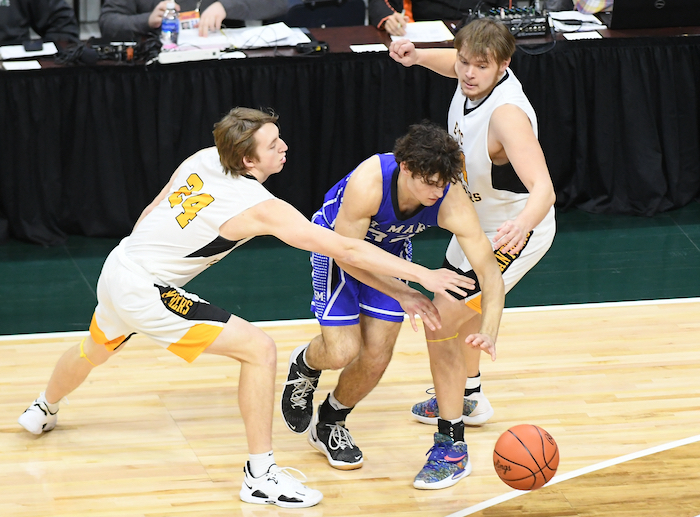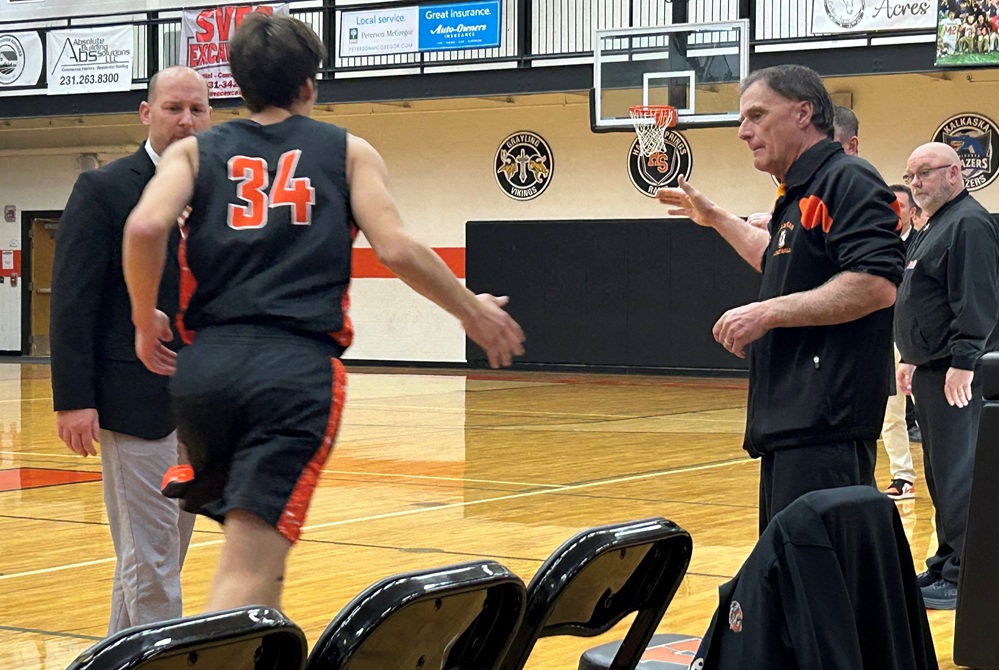
Ewen-Trout Creek Starts Fast, Holds On to Reach 1st Final Since 1982
By
Keith Dunlap
Special for MHSAA.com
March 24, 2022
EAST LANSING – What began playing out early like a certain blowout turned into quite a thriller to begin Thursday’s Division 4 Boys Basketball Semifinals at Michigan State University’s Breslin Center.
Making its first Semifinals trip since since finishing Class D runner-up 1982, Ewen-Trout Creek was in full control in the first Division 4 matchup of the night with a double-digit lead for the majority of the game.
But appearing in its first-ever Semifinal, Lake Leelanau St. Mary pulled off a furious comeback, tying the game with just over two minutes remaining.
Ultimately, Ewen-Trout Creek made more plays from there, holding off St. Mary to earn a 62-56 win and advance to its first championship game since it won the Class D title in 1972.
“Wow,” Ewen-Trout Creek coach Brad Besonen said. “That was fantastic. High school sports at its finest. Two small schools on the big stage at Breslin Center. These guys have dreamed about being here forever. They’ve played together since second grade.”
After trailing 48-31 with 1:55 remaining in the third quarter, St. Mary began its rally, mainly because it finally found some rhythm offensively.
 St. Mary scored the final six points of the third quarter to make it 48-37, but Ewen-Trout Creek restored its lead to 12 at 54-42 with 6:13 remaining.
St. Mary scored the final six points of the third quarter to make it 48-37, but Ewen-Trout Creek restored its lead to 12 at 54-42 with 6:13 remaining.
Then, the Eagles made their big move.
St. Mary went on a 14-2 run over the next 4:11 to tie the game at 56-56 with 2:02 remaining.
The comeback wasn’t anything new to the Eagles, who trailed by 18 in the second half of their District Final against Buckley and by 12 points in the final five minutes of their Regional Final against McBain Northern Michigan Christian before rallying to win both games.
“They just have no quit in them,” St. Mary coach Matt Barnowski said.
But down the stretch, Ewen-Trout Creek regained its composure.
Senior Jaden Borseth gave the Panthers a 58-56 lead with 1:46 remaining, and after St. Mary had 3-point shots rim out on back-to-back possessions, Ewen-Trout Creek took a lead with 33.8 seconds left on two free throws by senior Kelsey Jilek.
Following another missed 3-pointer by St. Mary, Borseth made two free throws with 8.2 seconds remaining to make it 62-56 Panthers.
Jilek led the way with 19 points and 11 rebounds, Borseth scored 18 points and senior Eric Abramson added 15 points for Ewen-Trout Creek (23-3), which had its eye on this year the minute last season ended with a loss to Bessemer in the District round.
“We were in the gym the day after we lost,” Jilek said. “We wanted more than anything to make a run last year. We put everything we had into it, and here we are.”
St. Mary junior Shawn Bramer led all scorers with 25 points to go along with eight rebounds, and Schaub added 14 points to lead St. Mary (21-5).
The Eagles started the season 2-3, then went 19-2 the rest of the way to make school history.
“That was a fun game,” Barnowski said. “Everybody got their money’s worth, there’s no doubt about that. I’m proud of these kids.”
Ewen-Trout Creek got off to a good start offensively, making nine of its first 15 shots and taking a 20-14 lead after the first quarter.
Leading 24-18 in the second quarter, the Panthers started to separate, going on an 11-2 run to take a 35-20 advantage with 1:08 remaining before halftime.
The Panthers eventually took a 37-22 lead into the break.
PHOTOS (Top) Ewen-Trout Creek's Eric Abramson lays up a shot during his team's Division 4 Semifinal win Thursday. (Middle) St. Mary's Shawn Bramer (32) works to split the defense of Kelsey Jilek (24) and Brendan Polkky (44). (Click for more from Hockey Weekly Action Photos.)

'Scott Hancock Court' Celebrates JV Coach's 50 Years Building Up Cheboygan Hoops
By
Tom Spencer
Special for MHSAA.com
December 19, 2025
It’s been a remarkable season so far for the Cheboygan boys basketball players and coaches.
 The undefeated varsity Chiefs are looking ahead to the new calendar year and their next opponent, Northern Shores Conference rival Elk Rapids. They also have the District tournament they’ll be hosting in February in their sights.
The undefeated varsity Chiefs are looking ahead to the new calendar year and their next opponent, Northern Shores Conference rival Elk Rapids. They also have the District tournament they’ll be hosting in February in their sights.
But Scott Hancock is already looking ahead to the classes of 2035, 2036, 2037 and 2038. And nobody can blame him.
Hancock, a 1976 graduate of Cheboygan, has no intentions of ending his coaching career soon. He’d like to make it long enough to coach his youngest grandson Lincoln Hancock, who is already playing youth basketball in Cheboygan.
And while the Chiefs are finding success this year with the foundation Hancock helped build, the veteran coach can’t help but dream about his youngest grandson playing at Cheboygan High School.
“As a kindergartner he’s in Saturday basketball, and he loves the game,” Hancock said. “God willing, I plan to be there for him.”
Hancock is his 50th season in Cheboygan program. He enjoyed the opportunity to coach his two sons Nick and Brian, both school record holders. He’s also enjoyed coaching his grandson, Landon Gahn, the Chiefs’ junior point guard. Gahn played junior varsity for Hancock his freshman year and moved up to the varsity his sophomore season.
All but two of Hancock’s season were spent as the JV coach. He took the varsity job on an interim basis when current Cheboygan varsity coach, Jason Friday, was playing for the Chiefs in the late 1990s.
On Dec. 9, the Chiefs officially named their home court the Scott Hancock Court. His family was on hand as well as current and former Northern Michigan coaches.
Hancock’s JV team lost that night to Alpena in overtime. The score was 50-50 when the fourth quarter buzzer sounded.
“Looking back, we should have just called the game at the end of regulation,” Hancock admitted. “I got a bunch of great kids this year. and it was a tough loss because it was an overtime loss.”
 It was the only loss the Chiefs’ JV team has encountered so far this year. But wins and losses are not the focus of Hancock’s level of the program.
It was the only loss the Chiefs’ JV team has encountered so far this year. But wins and losses are not the focus of Hancock’s level of the program.
“I don't get too carried away with the wins and losses — I know what I'm there for,” Hancock explained. “I'm there to teach the kids to get them ready for the varsity.”
Hancock is considered by many to be the best coach in Cheboygan history. No counter argument can be found among the current varsity players and their head coach.
“He's the best coach that I've ever had — no bias because he's my grandfather,” acknowledged Gahn, who was found cheering from the bench as the Chiefs secured the victory earlier this week at Kingsley. “He teaches everything about basketball, but he doesn't really preach as much as he demonstrates being a good person. Just looking at him and what he does every day, you can just tell he's the guy that's doing everything right, even though nobody's watching.”
Senior Carson Kiefer helped lead the way for Cheboygan's varsity at Kingsley. He scored 12 points, with two 3-pointers. Kiefer credits Hancock for helping him improve his confidence on the court.
“I think he cares more about the person individually outside of sports,” said Kiefer, who is averaging 16 points per game. “It's fitting that he's a JV basketball coach, helping build players’ skills and confidence.”
Kiefer’s twin brother, Andrew, singled out Hancock’s commitment to the school.
“He's not just a school figure,” said Andrew Kiefer, who is averaging just under 12 points per game. “He is not just the coach. He is a community guy all-around.”
The Chiefs varsity is getting strong contributions from their juniors this season. Nolan Schley is averaging 12 points per game, and he’s second on the team in rebounding. And Gavin Smith is leading the team in rebounds and assists, collecting almost 10 boards and four dishes per game.
The Kiefers, Smith and Schley are part of the reason Friday is not surprised by the 6-0 start and seeking a District title for the first time since 2015. The last time Cheboygan won a conference championship was 2020, playing in the Straits Area Conference during Friday’s first season as boys head coach after previously coaching the girls varsity.
 “We knew that our junior and senior classes had some talent in there,” Friday noted. “The boys really want to win a District championship, as well as a conference championship. The boys put a ton of time in the offseason to do everything they can to get over that hump and get both a conference and District championship.”
“We knew that our junior and senior classes had some talent in there,” Friday noted. “The boys really want to win a District championship, as well as a conference championship. The boys put a ton of time in the offseason to do everything they can to get over that hump and get both a conference and District championship.”
Cheboygan will host a Division 2 District tournament this season after falling 50-48 in last year’s Division 3 District Final – also at home. The Chiefs face a field including league foes Grayling, Kalkaska and Kingsley as well as Ogemaw Heights and Sault Ste. Marie. Cheboygan topped the Sault 67-43 earlier this year and will play a home-and-home series with Grayling in January.
For now, though, the Chiefs are thinking only about Elk Rapids. Cheboygan started 7-0 last year before falling to the Elks to start the new year.
“We're approaching 7-0 again, so having them coming up here on the schedule, we’re definitely going to be practicing a little harder and watching maybe a little more film and just preparing for the game more seriously,” Gahn said. “Coach Friday was saying last year that he can't remember the last time the team started off 8-0, and it was our eighth game that we lost to Elks. So we're hoping to beat them next time we play.”
The court naming did not come as a surprise to Hancock. He was informed in a meeting with Marty Mix, Cheboygan principal. He thought he had some papers to sign and was surprised his family was waiting in the office.
“He was completely shocked, and Coach Hancock doesn't like attention,” said Friday, who is also the school’s athletic director and was in the notification meeting. “Scott always likes to be in the background, and he handled it quite well.”
And while his signature was placed on the court opening day this year, he points out the Hancock legacy started way before him.
“I'm more proud of the Hancock name on there more than the Scott part of it,” said Hancock, who also serves as the city’s as the parks and recreation director. “Believe me, my dad was a Chief through and through. He passed in 2006. I know he was there in spirit with us looking down.”
 Tom Spencer is a longtime MHSAA-registered basketball and soccer official, and former softball and baseball official, and he also has coached in the northern Lower Peninsula area. He previously has written for the Saginaw News, Bay County Sports Page and Midland Daily News. He can be reached at [email protected] with story ideas for Manistee, Wexford, Missaukee, Roscommon, Ogemaw, Iosco, Alcona, Oscoda, Crawford, Kalkaska, Grand Traverse, Benzie, Leelanau, Antrim, Otsego, Montmorency, Alpena, Presque Isle, Cheboygan, Charlevoix and Emmet counties.
Tom Spencer is a longtime MHSAA-registered basketball and soccer official, and former softball and baseball official, and he also has coached in the northern Lower Peninsula area. He previously has written for the Saginaw News, Bay County Sports Page and Midland Daily News. He can be reached at [email protected] with story ideas for Manistee, Wexford, Missaukee, Roscommon, Ogemaw, Iosco, Alcona, Oscoda, Crawford, Kalkaska, Grand Traverse, Benzie, Leelanau, Antrim, Otsego, Montmorency, Alpena, Presque Isle, Cheboygan, Charlevoix and Emmet counties.
PHOTOS (Top) Longtime Cheboygan boys basketball JV coach Scott Hancock sends a starter onto the floor during introductions before a game against Kingsley. (Middle) The Hancock family takes a photo with Scott’s newly-added signature on the floor. From left: Landon Gahn, Brian Hancock, Olwyn Hancock, Scott Hancock, Marjean Hancock, Lincoln Hancock and Nick Hancock. (Below) Scott Hancock shakes hands with a Kingsley assistant coach. (Family photo courtesy of Chris Murdick. Other photos by Tom Spencer.)

